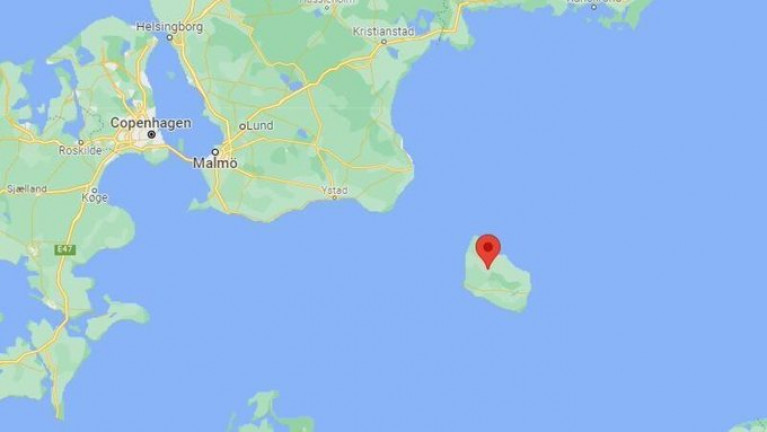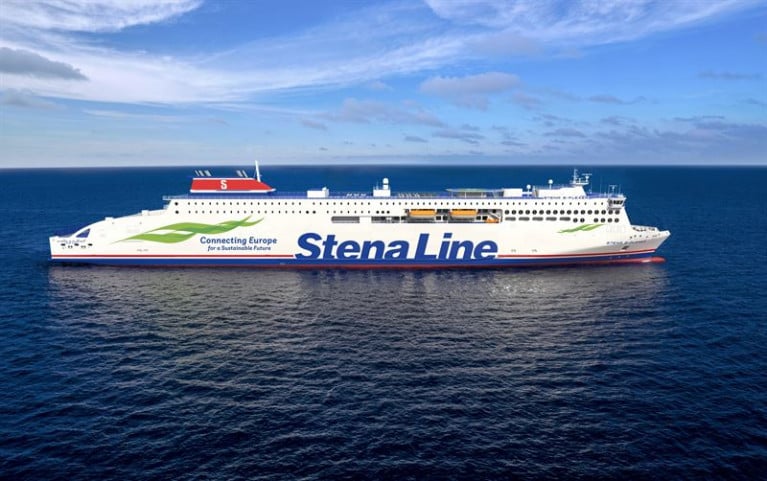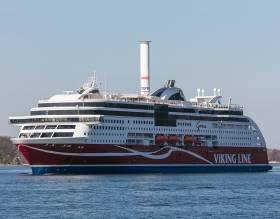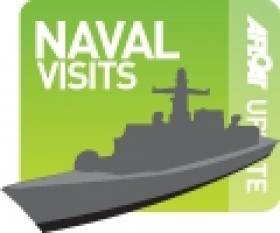Displaying items by tag: Baltic Sea
Baltic Sea: Danish & Swedish Authorities Said Cargoship Rescue Operation Under Way for at Least Two Crew
In the Baltic Sea two cargo ships have collided in an area between the Danish island of Bornholm and the southern Swedish city of Ystad.
As RTE News reports, the Danish and Swedish authorities said a rescue operation was under way for at least two people.
The ship Karin Hoej, registered in Denmark, had capsized and was upside down, the Swedish Maritime Administration said.
It had two people on board and they were missing, the Danish Defence's Joint Operations Centre (JOC) said.
The other ship, the British-registered Scot Carrier, was functional and its crew was safe.
Click here for more.
Afloat adds to track the current position of the Scot Carrier,click here.
'E-Flexer' Class Ferries to Join Stena Line’s Baltic Sea Fleet Next Year
Stena Line which operates three of their 'E-Flexer' ro-pax class ferries on the Irish Sea, is to continue its expansion on the Baltic Sea during 2022, increasing both freight-and passenger capacity with larger versions of the new class.
The Swedish family-owned ferry company today announced that they will deploy their two new 240-meter-long fuel-efficient E-Flexer* ferries, on the Nynäshamn (Sweden)-Ventspils (Latvia) next year.
Stena Line also announced plans to increase the capacity on the Karlskrona (Sweden)-Gdynia (Poland) route with the deployment of the two large and modern ferries Stena Scandica and Stena Baltica. This pair, Afloat adds were formerly operating on the Irish Sea on their Belfast-Birkenhead (Liverpool) route until replaced by two E-Flexers and following introduction of class leadship Stena Estrid on the Dublin-Holyhead route in 2020.
Over the past year, Stena Line has expanded in the Baltic Sea, increasing both freight and passenger capacity, to cater for increasing demand of sea transportation in the region. This year Stena Line have already introduced new large and modern ferries on both of their two Latvian routes Nynäshamn-Ventspils and Travemünde (Germany)-Liepaja (Latvia).
Today, the ferry company announced that their expansion on the Baltic Sea will continue during 2022. Next year Stena Line will deploy their two new 240-meter-long fuel-efficient E-Flexer* ferries on the Nynäshamn -Ventspils route. The ferries will have a capacity for 1,200 passengers, an increase of 33% compared to existing ferries, and a total of 3,600 meters of freight lane meters, an increase of 25%.
“We continue growing together with our customers by strengthen our position and fleet across the Baltic Sea. Demand for capacity in the region keeps increasing as freight customers continue to expand and travel passengers choose ferry travel as their preferred safe form of transport in the wake of the pandemic. These large, modern, and fuel-efficient next generation ferries are the flag ships in the modernisation of our fleet as well as our development of sustainable shipping” says Niclas Mårtensson, CEO Stena Line Group.
Up to 30 % more energy efficient
Stena Line’s position as the leader in sustainable shipping is clearly visible and the new vessels are among the most energy efficient RoPax ferries in the world. The E-Flexer ferries are up to 30 % more energy efficient than existing vessels, thanks to optimum design of the hulls, propellers, bulbs, and rudders.
The vessels are delivered gas-ready, to allow conversion to methanol or liquid natural gas fuel. The new ferries will be equipped to use shore power during port calls to reduce emissions and the electricity connection also enables a conversion to battery hybrid in the future. The vessel will offer efficient loading and unloading with drive-through lanes on the two levels.
“Stena Line’s Scandinavian heritage is clearly visible on the interior and the design is spacious and light, with amazing panoramic views. The new vessels will offer our passengers a brand new onboard and travel experience on Ventspils-Nynäshamn, the shortest route between the Baltics and Scandinavia”, says Johan Edelman”, Trade Director Baltic Sea North, Stena Line.
Capacity increase on Karlskrona (Sweden)-Gdynia (Poland).
Stena Line today also announce their plans to increase the capacity on the Karlskrona-Gdynia route further during 2022 with the deployment of the two large and modern 222-meter RoPax ferries Stena Scandica and Stena Baltica. The two Visentini vessels has recently been lengthened and modernised and will add 30 % freight capacity and a brand new modern onboard experience for both drivers and passengers on the Karlskrona-Gdynia route.
*Ferry facts: E-Flexer ferries
The two 240-meter E-Flexer (MkII) ferries are designed in collaboration with Stena RoRo and is currently being built at the CMI Jinling Shipyard in Weihai, China, with expected delivery during 2022.
Stena Line has previously introduced the three 214-meter E-Flexer ferries Stena Estrid, Stena Edda and Stena Embla on the Irish Sea during 2019-2020. The E-Flexer ferries are among the most energy efficient RoPax ferries in the world, up 30 % more energy efficient than existing vessels, thanks to optimum design of the hulls, propellers, bulbs, and rudders.
Route: Nynäshamn (Sweden) – Ventspils (Latvia)
Names: not yet revealed by Stena Line
Length: 239,7 m
Breadth: 27,8 m
Lane meters: 3,600
Passengers: 1200
Cabins: 263
Baltic Ferry Becomes First Passenger Ship in the World to Use Rotor for Wind-Assisted Propulsion
#FerryNews - Scandinavian operator, Viking Line based in Finland, has announced that its LNG fuelled cruiseferry M / S Viking Grace has become the first passenger ship in the world to utilize wind power through mechanical rotor driving.
The rotor sail developed by Norsepower, Finland, saves fuel and reduces emissions. The Viking Line will enter the sailing on the ships routine Turku-Stockholm route with the help of winds.
M / S Viking Grace's 24-meter-high and four-meter wide rotor cask is based on the Magnus phenomenon. When the sail spins, its surface pulls air on one side at less pressure than on one side. The differential pressure generates thrust that moves the ship forward. The sail functions automatically, and the system stops if the direction or intensity of the wind changes to the ship as unfavorable. With rotor dinghy, the ship's emissions are reduced by up to 900 tonnes per year depending on wind conditions.
The introduction of rotor dinghy reflects the green values of Red ships. For the Åland shipyard, the sea and the archipelago have been a heartbeat and a prerequisite for livelihood for decades. M / S Viking Grace, which started operations in 2013, is already the world's most environmentally friendly ship: it moves with liquefied natural gas and is low in emissions and low noise. Thanks to the new sail, the Turku archipelago is sailing even more environmentally friendly.
This is a great day for us. As an Ålandian shipping company, we live in the sea, so promoting our well-being is of great importance to us. We want to be the forerunners in utilizing solutions that reduce environmental loads. Norsepower, a Finnish manufacturer of mechanical rotor cranes, is the world's leading solution to reduce fuel consumption and it is immensely great for us to introduce this innovation to M / S Viking Grace as the first passenger in the world, "says Jan Hanses, President of Viking Line .
Norsepower, a Finnish cleantech company, has developed its rotor blade for five years. The idea of a rocket sailor is already about a hundred years old, but as the environmental requirements become more intense and as material and technology solutions develop, the solution has become very topical and interesting. Norsepower has been in the development for many years ahead of other players.
In addition to the M / S Viking Grape-mounted rotor crane, Viking Line's new, 2020-ready vessel will benefit from wind propulsion technology. Two Norsepower mechanical sails will be installed on a passenger ship built in China, and thus the potential for wind power will be doubled.
Killer Whale Pair Spotted Near Kinsale
#MARINE WILDLIFE - Two killer whales have been spotted near Kinsale in recent weeks, the Irish Whale and Dolphin Group (IWDG) reports.
Two separate sightings of the orca pair near Barry's Head have been confirmed by the group, via photos provided by John Murphy and Richard Cussen on 5 March, during what is normally the 'low season' for whale watching in Ireland.
The pair comprises one adult male and a smaller whale which is likely an adult female. It is not yet known, however, whether the whales are new to Irish or Scottish waters.
According to the IWDG's Pádraig Whooley, it is "interesting that they have stayed close to their original position and suggests they may have found 'rich pickings'".
In other news, the Whale and Dolphin Roadshow will be at the Galway Shopping Centre from 22-25 March in time for the European Cetacean Society Conference.
The roadshow "is a fantastic opportunity to learn more about whales, dolphins and porpoise of the ASCOBANS region" that encompasses the Baltic Sea, Northeast Atlantic and Irish and North Seas.
Stena Superfast VII Departs Poland for New Belfast-Cairnryan Route

The New Superfast leaves Gdansk
The 30,285grt newcomer and her sister Stena Superfast VIII will become the largest ever ferries running on the North Channel , though prior to entering service on 21 November, they will undertake berthing trials and crew training.
For the next two-years the sisters are on charter from Scandinavian operators Tallink, and are to operate the new 2 hour 15 minute route with 12 crossings daily. The ten-deck ships can carry up to 1200 passengers, 660 cars or 110 freight units. The sisters will be re-gistered in their new homport of Belfast.
The relocation of Scottish ferry port and the introduction of the Superfast sisters will replace the existing pair of conventional ferry tonnage, Stena Caledonia and Stena Navigator (1984/15,229gt) the latter vessel is believed to be sold. In addition HSS sailings will cease causing the HSS Stena Voyager to become redundant, she was the second of the trio of pioneering HSS 1500 craft built.
When Stena Superfast VII departed Gdansk, she passed the Stena Vision which operates Stena Line's Karlskrona-Gdynia route, the Baltic Sea city lies to the west of Gdansk. Also in Gdansk was the Stena Feronia, the former Irish Sea serving Visentini built ro-pax Dublin Seaways, which was operated albeit briefly by DFDS Seaways last year on the Dublin-(Birkenhead) Liverpool service.
She served under her new Scandinavian owners but the firm's first foray into the Irish market lasted a mere six months. DFDS Seaways sold their Irish Sea network to Stena Line (to read report click HERE) with the exception of their Dublin-Birkenhead service which closed. In addition the Dublin-Heysham freight-only route which closed until re-opened by Seatruck Ferries. The route is currently served by Anglia Seaways, the freightferry which DFDS previously used on the route is on charter to the operator.
- DFDS Seaways
- Baltic Sea
- Stena Line
- Ports and Shipping News
- Seatruck Ferries
- North Channel
- Stranraer
- Dublin Seaways
- Ferry news
- Tallink
- Loch Ryan Port
- HSS Stena Voyager
- Stena Caledonia
- Stena Navigator
- Belfast Lough News
- HSS
- Visentini ropax
- BelfastCairnryan
- Stena Superfast VII
- Stena Superfast VIII
- Stena Superfast
- Superfast Sisters
- North Channel ferry routes
- Stena Feronia
- LRP
- BirkenheadBelfast
- DublinBirkenhead
Finnish Minelayer to Visit Cork
The Finnish Navy minelayer FNS Hämeenmaa is to dock in the Port of Cork at the city's central North Custom House Quay tomorrow morning, writes Jehan Ashmore.
FNS Hämeenmaa entered service in 1992 and measures 1,450 tonnes, she is the namesake class of two minelayers, the second FNS Uusimaa was also built by Finnyards in the same year.
At nearly 78m long the steel hulled vessels which have an alloy superstructure are designed to operate throughout the year in the demanding Baltic Sea conditions and the in the archipelago's.
They have an ice operating classification of ICE-1A and for military purposes they became one of first Finnish Navy vessels to incorporate stealth technology features. The pair are primarily tasked for minelaying duties but they also provide roles acting as an escort, transport and depot ships.
Armament comprises of 1 × Bofors 57 mm dual-purpose gun, 1 × eight-cell ItO 04 surface-to-air missile launcher, 2 × anti-submarine rocket launchers, 2 × depth charge rails and 100-150 sea mines (four mine laying rails).
Based in Pansio, the 20 knot vessels each have a crew complement of 60 personal. In total the Finnish Navy has around 2,100 officers, officer specialists and warrant officers, military personnel and civilian's workers.
On an annual basis close to 3,900 conscripts, of which approximately 30 are women volunteers do their military service in the navy. In addition about 3,400 reservists are trained yearly in naval refresher courses.
Ulysses Celebrates 10 Years of Irish Sea Service
In January 2000 the keel of the worlds largest car ferry was laid at the Aker Finnyards in Rauma, Finland. The following year the €100m cruiseferry giant departed the shipyard on a four-day delivery voyage to Dublin Port. Upon Ulysses's arrival on 4th March she was presented with a traditional welcoming escort of saluting water-firing tugs.
The Ulysses was named at a ceremony in the port on 21st March by the 'golden godmother' Mairead Berry, Ireland's 25-year old Paralympic Games gold medallist. Four days later Ulysses made her commercial maiden voyage to Holyhead on 25th March.
Wih 12 decks the vessel has an extensive range of facilities and they are named with themes derived from James Joyce's famous novel 'Ulysses'. There is seating available for up to 1,938 passengers and there are 117 twin or single-cabins, accommodating up to 228 passengers.
Only two months into service the Ulysses won the prestigious 'Most Significant New Build - Ferry' category award in the Cruise & Ferry magazine 2001 Awards competition. Her Finnish builders are not only builders of large cruise-ferries for Baltic Sea operators and beyond but also are also renowned for the construction of very large cruiseships for international clients.
Ulysses was designed specifically to serve the central corridor route with a schedule of two round trips daily. She directly replaced the 1997 Dutch built 34,031 grt ro-pax Isle of Inishmore, which transferred to Rosslare-Pembroke Dock service.
In 2006 the Ulysses alongside her fleetmates were transferred from the Irish flag to the Cypriot flag in addition to a change of Irish crew with those outsourced from citizens mostly from the Baltic and Eastern European countries.
Due to the sheer size of the Ulysses, which has a length of 209m, a beam of nearly 32m and a 6.4m draught, she has not missed a single crossing due to bad weather conditions. The vessel has a 22 knot / 41kph service -speed on the 60-mile route which translates to a distance of over 182,000 kms a year.
To celebrate Ulysses 10th year in service, Irish Ferries has enhanced the Club Class option to passengers which includes free-Wifi, which enables a constant connection and an array of other benefits during the 3-hour 15 minute crossing.
For a virtual tour of the Ulysses with views taken from the top deck as the cruiseferry departs Holyhead and the mountains of Snowdonia setting as a backdrop plus interior tours of the vessel click here.
Brittany Ferries Re-Open Bilbao Route
The Cap Finistere has a 790 passenger / 500 vehicle capacity and the vessel will operate two round trips weekly with each crossing taking 24 hours. Interestingly an additional en-route call to Roscoff is scheduled on Sunday sailings bound for Bilbao which will take 33-hours. This is to facilitate a crew change, as the Cap Finistere does not operate on any of the company routes from France.
In 2009 the P&O service carried 180,000 passengers and 193,000 in 2008 but closed due to "unsustainable losses". There were 800 redundancies but some 150 staff jobs were secured through transfer. Click here for a previous posting. The company were in direct competition with Brittany Ferries existing two routes between Plymouth and Poole to Santander.
The Bilbao route brings the Brittany Ferries operations to five sailings weekly between the UK to Spain, two from Portsmouth to Santander and a single round-trip to Plymouth.
The Pride of Bilbao was sold late last year by ICG to the Baltic Sea based St. Peter Line at a profit of €9.4m. The vessel underwent refurbishment and was renamed Princess Anastasia and next month starts a new St. Petersburg-Stockholm service, with Russian bound sailings calling en route to
the Estonian capital of Tallinn. Click here for more details.
Pride of Bilbao's return to the Baltic is nearly full-circle as the 2,553 passenger / 600 vehicles vessel, built in 1986 as Olympia for Viking Line's also operated out of Stockholm to Helsinki, and at the time was one of the largest overnight passenger capacity ferries in the world.
Irish Continental Group Record 61% Rise in Profit
The Irish Continental Group (ICG) which is the parent company of Irish Ferries, has warned of 'uncertainty' in 2011 due to higher fuel costs and the effects of the austerity measures in both the Irish and UK economies.
ICG secured a 61% increase in pretax profits in 2010 following an increase in passenger numbers and the sale of their MV Pride of Bilbao to St. Peter Line (click here) after a long-term charter to P&O Ferries. The 37,583 gross tonnes cruiseferry is to open a new second route for the Baltic Sea operator between St. Petersburg and Stockholm, starting next month.
To read more about ICG's end of year results, click the report in today's Irish Times.
Bilbao Returns to Baltic Sea 'Roots'
For the last 17 years the Pride of Bilbao has operated between Portsmouth and Bilbao under charter to P&O. Built in 1986, she was launched as Olympia for Viking Line between Stockholm and Helsinki, then the Baltic Sea ferry was one of the largest overnight passenger capacity ferries in the world. At 177 metres long the vessel can accommodate 2552-passengers, 600-vehicles and space for 77-trucks. She has a sister, the Mariella, which currently operates on Viking Line's Stockholm-Mariehamn–Helsinki service.
In 1993 the vessel was renamed Pride of Bilbao and launched a new service on the Bay of Biscay, under charter from her Scandinavian owners. The following year ICG purchased the Pride of Bilbao from Viking Line and she was re-registered to the Bahamas. The vessel was subsequently entered into a British bare-boat charter arrangement between P&O Ferries and ICG. Due to unsustainable losses the route closed on 28 September this year but rivals Brittany Ferries soon shortly announced they would reopen the route in Spring 2011.
Throughout the Pride of Bilbao's career under ICG (parent company of Irish Ferries), the cruiseferry has only once visited Ireland. In between Spanish sailings, she was sub-chartered for a three-day Christmas mini-cruise from Portsmouth to Dublin in 2004, where the Pride of Bilbao berthed at the ferryport close to the ICG headquarters.







































































